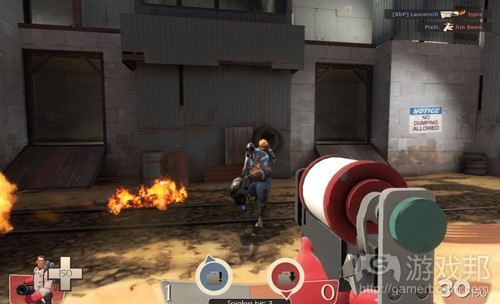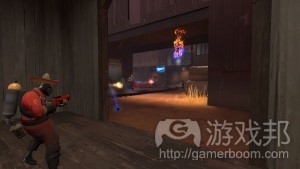阐述元游戏设计对多人游戏的影响
作者:Josh Bycer
设计元游戏进程可以增加游戏比赛的持久性。过去10年来,《军团要塞2》引领着该模式蓬勃发展。其中增加新道具机制(游戏邦注:无论是装扮类还是功能类)总能留存住玩家。
《军团要塞2》的热度并没有销声匿迹,自那时起,越来越多的多人游戏在设计时总会考虑到元游戏方面:比如《英雄联盟》与《使命召唤》等。一方面,这种设计具有一定优势,能维持多人游戏社区长期运作。然而对那些使用不当的游戏,它会带来何种影响?
过去
《军团要塞2》在多人游戏中增加元游戏设计前,大多数射击游戏主流用户的留存期十分有限。比赛间唯一记录的是与玩家的基本数据:比如赢/输,消灭的敌人数量等。由于没有对游戏角色进行任何形式的改善,因此旧式射击游戏的技能上限设置偏高。
如果你打算在一款全新多人游戏问世后投入数个月的游戏时间,那你应做好遭受骨灰级玩家(游戏邦注:他们每天都会体验这类游戏)打压的准备。由于进程上的局限,大多数休闲与主流用户不会长期停留于此,结果留下的是那些数月来致力于研究地图与玩法的玩家。
由此可见,大部分多人游戏鲜少在问世一年后仍保持活跃势头。当然它们仍在运行中,只是仅有少数骨灰级玩家参与其中。
道具机制
在《军团要塞2》首次作为橙盒版的一部分推出时,其比赛之间同样缺乏持久性。但Valve决定做出调整,首先是仅提供成就型道具。随后几年,该作已陆续推出帽子装饰、定时掉落道具、锻造道具、交易模式、道具商店,以及现在的免费模式。
如今,同比发行初期,《军团要塞2》是款完全不同的作品。比如最近Valve推出了市场beta测试,即你可以出售该作道具换取Steam Wallet现金,而后用它在Steam平台上购买其它物品。
(《Natural Selection 2》是其中一款在2012年推出,且不含任何元游戏内容的多人游戏。)
比如在发行头年,《军团要塞2》已打破多人射击游戏的存活曲线模式,距今已盛行5个年头。一时间市场上也涌现大量意在传递这种持续性的新作。
有趣的是,这些游戏要么是AAA游戏(如《使命召唤》),要么是独立游戏(如《Guns of Icarus Online》),要么是免费游戏(如《英雄联盟》)。
一方面,《军团要塞2》中元游戏的成功为该作留存了大量活跃玩家。但也有不少玩家因此停止体验。该作评论家认为,此问题具有双重效果。
首先是道具模式的出现导致该作技能曲线的降低。因为越来越多角色等级道具的使用降低了玩家技能的重要性。而对于那些希望自身技能成为制胜关键的玩家而言,道具显然会混淆游戏结果。
同时,围绕元游戏设计或免费模式创建的游戏也存在此类问题。其中,高技能水平玩家比那些多次体验该作并累积大量道具的玩家更处弱势。虽然Valve已保持这两方面的完美平衡,但道具本身有时仍会成为障碍。
(《军团要塞2》中的库存系统正稳步进展,成为玩家体验该作的主要动机。)
另外,虽然该作的道具收集已成为主要元素,但它们仍与游戏结果无关。
赢得/输掉一个回合或比赛并不会影响道具解锁与奖励。因此玩家的举动如同完成支线任务,重点是获得道具。
长时间体验该游戏的玩家认为,关注道具与内容会削弱游戏进程与体验。因此,焦点主要聚集在道具收集,而不是团队间的作战。
既然如此,你可能认为最简单的方法是创建短暂性的多人游戏,但我们发现这也会引发问题。
简短的多人游戏
虽然理论上讲,制作不具永久性的复杂多人游戏是个可行策略。但在如今世界中可能会被当作老套做法。
回想多人游戏还未改变或进展时,骨灰级玩家以及天天泡在此类游戏中的用户占领极大优势。然而如今,《军团要塞2》与《使命召唤》中的所有内容都在呈现一种永久感,因此我们难以回到过去。
最近我试着体验《Natural Selection 2》:这是款双方战略机制不对称的团队对抗射击游戏。同比市面上的射击游戏,该作无疑尝试了某些不同做法。然而,由于不具持久性,其中的比赛在开始不久后便混为一体,使我觉得好像再次陷入同个错误。
更糟的是,那些体验过《军团要塞2》与《行星边际2》的玩家会认为,你玩《Natural Selection 2》实则是在浪费时间,因为在其它作品中,投入越多时间可以体验更多内容。
一旦你了解游戏提供的所有内容,那么体验该作的目的就仅是为了竞争。这有利于骨灰级玩家,而新手则难以掌握它的玩法。
到目前为止,我们已经探讨不含元游戏内容会引发的问题,最后,我们将讨论平衡元游戏与微交易内容的难度。
“付费取胜”的劣势
在平衡元游戏系统时,应确定技能在元游戏或微交易模式中的重要性。Valve的《军团要塞2》已在该方面取得巨大成功。虽然其中仍存在大量元游戏内容,但技能仍是制胜的重要因素。
如果最初你无法准确定位,那么你为士兵配备何种火箭发射器并不是重点。这主要因为《军团要塞2》中的道具只具备侧升级作用,不会完全提升玩家等级。
可是,如果元游戏内容通通围绕升级进行设计,这就会让我们想起“付费取胜”这一理念。
(《行星边际2》的商店提供一系列道具,总会赋予玩家一些新期待。)
在《行星边际2》中,玩家可以使用完成目标或消灭敌人赚取的积分,购买新装备,或是提高已解锁道具的性能。同时他们还可使用AKA购买道具。
问题是,同比初始阶段使用的道具,你在其中购买的道是纯升级功能。结果,你会困惑于是投入大量时间,使用不大精良的武器赚取积分与必要升级,还是付费快速获得更加出色的道具。
多数情况下,如果一开始使用的是劣质武器,那么你所具备的熟练与准确程度并不是重点。抢先瞄准另一个玩家,而后才发现其等级较高并能轻易致你于死地并无多大益处。
结果,如同不含元内容的游戏中的情况一样:等待体验的时间越长,玩家之间的技能差距越大。而在可购买的游戏内容中,元内容差距会越发明显。
当新手首次进入该作时发现人人都已购买更加精良的装备,此时他们处在极大劣势,且随着进程继续表现得越发糟糕。
从设计师与运营人员身份考虑
如我们所见,过去十多年来,多人游戏范围已发生根本性变化。如今设计师着眼于通过鼓舞玩家,长期留存他们。
比如《英雄联盟》与《使命召唤》已建立起强大社区。但运作有误可能会影响游戏寿命,赶跑玩家。
制作强大的元游戏并不像拥有一家游戏商店,而后坐等现金汇入那般简单。它必须有意义地整合到玩法中,同时允许不付费用户继续体验进程。
(不管《军团要塞2》中道具种类的多样化,它们总是无法取代玩家技能。)
虽然制作纯升级模式可以获利,但这只是短期性,而且会长期失去玩家基础。
这也是装扮道具盛行的原因:它们能够提供游戏动机,同时不会扰乱玩法。总之:如果元内容在某些方面会削弱游戏玩法,那我们应不惜一切代价避免这种情况发生。
在在线游戏方面,我们不再着眼于吸引你的注意力,只是随着更多作品的发行会更加注重这方面;设计师与玩家都应留意那些仅对一方有利的元游戏内容。好比最近《War Z》的失败表明:微交易模式不会自动促使游戏向积极方向发展。(本文为游戏邦gamerboom.com编译,拒绝任何不保留版权的转载,如需转载请联系:游戏邦)
Meta Game: Adding Purpose or Shoehorning Design?
by Josh Bycer
Meta game design has become a major change in multiplayer design: Greatly extending the life span of online games. But, has everything been a positive growth for online games?
Reprinted from my site: Game-Wisdom
Meta game progression is the design of adding permanence between different plays of a game. Over the course of the last decade it has flourished with Team Fortress 2 leading the way. The mechanic of adding new items, both cosmetic and functional gave players a reason to stick around.
The popularity of Team Fortress 2 did not go unnoticed and since then, more multiplayer titles are being designed with a Meta game in mind: from League of Legends, to Call of Duty and many more. In one way this is good, as it helps to keep a multiplayer community going for a longer period of time. However while it’s great for games that make use of it, what happens to those that don’t?
The Old Days:
Before Team Fortress 2 started adding Meta game design to multiplayer, most shooters had a limited shelf life with the mainstream audiences. The only thing that was tracked between matches was the basic stats of the player: Win/Lost, enemy’s killed etc. Without any form of outside improvement for in-game characters, the skill ceiling of older shooters was very high.
If you wanted to start playing a new multiplayer game several months after its release, prepared to be overwhelmed with expert players gunning you down, who have been playing the game every day. As due to the limits of progression, most casual and mainstream fans won’t stay around for the long run leaving you with the people who have been learning the maps and gameplay for months.
Because of this, most multiplayer games barely stayed active beyond a year after release. They are still being played, but by a minority of expert players.
Hat Power:
When Team Fortress 2 was first released as a part of The Orange Box, it had the same lack of permanence between matches that every other shooter had before it. But Valve decided to change that, first with achievement only items. Over the next few years this blossomed into hats, timed drops, crafting, trading, the item store and now being free to play.
Today, Team Fortress 2 is a completely different game then it was in its first year. And as we’re talking now, Valve has recently released the marketplace beta where you could now sell Team Fortress 2 items for Steam Wallet Cash, which can be used on anything on Steam.
Speaking about getting past the first year, Team Fortress 2 has beaten the curve for multiplayer shooters and is over five years old. With that success, we have seen a number of new games aimed to deliver that same level of persistence.
What’s interesting is that these games run the spectrum of AAA developed games (Call of Duty), Indie games (Guns of Icarus Online) and free to play (League of Legends).
On one hand the success of Team Fortress 2′s Meta game has helped keep it full of active players. But there are plenty of people who have stopped playing because of it. The problems for the critics of Team Fortress 2 are twofold.
First, is that the skill curve of playing Team Fortress 2 has gone down for some with the inclusion of items. The reason is that the more character progression items available, downplays the player’s skill. For player’s who like their own skill at the game to be the best factor at winning, items tend to muddle the results.
This is also something that we see in other games built around Meta-game design or free to play. Where, a player with a high skill level is weaker compared to someone who has played the game more and has accumulated more items. While Valve has done an admirable job in keeping balance in Team Fortress 2, the items themselves have become a barrier to some.
The other problem with Team Fortress 2 is that while the inclusion of items has become a major element of the game, they are still divorced from the result of playing.
Winning or losing a round or a match has no bearing on item unlocks or rewards. This has made the act of actually playing Team Fortress 2 for some people, into a side activity with a focus on in items.
For long time players, many felt that the increased focus on items and content took away from playing the game and diluted the experience. And that collecting items have become the main focus instead of the team vs. team matches.
Now, you would think that the simplest solution would be to just create a multiplayer game without any persistence, but as we’ve also seen that has its own share of problems.
A Return to the Old Days:
While the thought of having a complex multiplayer game without any persistence looks good on paper. In today’s world, it can be seen as archaic.
Returning to the days where multiplayer games never change or grow is great for the expert players or the people who play it every day. But now, with everything from Team Fortress 2 to Call of Duty and so on offering a sense of permanence, it’s hard to go back to the old days.
Recently I tried playing Natural Selection 2: a team vs. team shooter with asymmetrical sides with some strategy game mechanics. The game definitely tries something different compared to other team based shooters on the market. However, without permanence, the matches started to blend together after awhile and it felt like I was just doing the same thing over again.
What’s worse is that for someone who plays other titles like Team Fortress 2 or Planetside 2, it can feel like you’re wasting your time playing a game like Natural Selection 2 where you have these other games that give you more things to do the more you play.
And once you’ve reached a point where you’ve seen everything the game has to offer, there is no other reason to keep playing outside of for competitive purposes. This is great for expert players, but once again leaves the game difficult for someone new learning how to play.
So far we’ve talked about the issues of no meta-game content, but for our last point, balancing both meta-game and micro transaction content can be just as tricky.
The dreaded “Pay to Win”:
The challenge of designing a balanced meta-game system is determining how important skill is over the Meta game or micro transaction model. This is one area that Valve has largely succeeded with Team Fortress 2. While there is a lot of Meta game content, skill is still an important factor of winning.
It doesn’t matter what rocket launcher you have for the solider if you can’t aim properly in the first place. This is primarily due to the items in Team Fortress 2 acting as side-grades instead of full blown upgrades for your character.
But if the meta-game content is designed around upgrades, then we see signs of “pay to win” coming into the picture.
In Planetside 2, players can use credits which are earned by completing objectives and killing enemies to buy new gear, or enhance ones already unlocked. Items can also be bought using station cash AKA purchasable currency.
The issue is that the items that you can buy in PlanetSide 2 are pure upgrades compared to what you start out with. Leaving you with the choice to either spend a lot of time with less than adequate weapons to get the credits and upgrades needed, or spend money and get better items fast.
In many cases, it doesn’t matter how skilled or accurate you are, if you’re using a crappy weapon to begin with. Getting the drop on another player to then discover that they are a much higher level then you and can kill you easily is not a good time.
What ends up happening is a similar situation that we see in games without a meta-game: Where the longer you wait to play, the more the skill gap widens. But in a game with purchasable content it’s the Meta content gap that gets worse.
When someone new starts playing to find that everyone already has bought better gear, they are at a huge disadvantage that becomes worse the longer the game is out.
Being Both Designer and Accountant:
As we can see, the scope of multiplayer games has changed radically over the last decade. A new goal for designers is to keep their respective game being played for a long period of time by giving incentives to the players.
In cases like League of Legends and Team Fortress 2: It has given games a strong community. But if done incorrectly or not at all, it can hurt the game’s life span and drive people away from a title instead of pulling them in.
Creating a strong meta-game is not as simple as having an in-game store and sitting there waiting for cash to come in. It has to be integrated meaningfully into the gameplay while still allowing people who don’t (or can’t) spend money to progress.
The allure of creating pure upgrades for cash is a strong one, but at the same time it can lead to short term gain, for long term lost of your player-base.
This is why cosmetic items are the most popular: as they provide incentives, without upsetting gameplay. As a general rule: If the Meta content in some way trivializes actually playing the game, this should be avoided at all costs.
The focus of getting your attention (and money) when playing online games has never been greater and will only become larger as more games are released; both designers and players need to watch out for meta-game content that only benefits one side. Like the recent fiasco behind War Z showed: micro transactions do not automatically make a game better… or finished for that matter.(source:gamasutra)












































 闽公网安备35020302001549号
闽公网安备35020302001549号